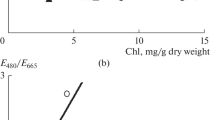Abstract
The chlorophyll, ash, carbon, nitrogen and phosphorus levels in seven species of freshwater macrophytes (Juncus effusus L., Iris pseudacorus L., Carex rostrata Stokes, Glyceria maxima (Hartm.) Holmberg, Nuphar lutea (L) Sm., Polygonum amphibium L. and Schoenoplectus lacustris (L) Pallas) in three Scottish lochs of different trophic levels were studied during 1975. Mean chlorophyll levels varied from a minimum of 1.73 mg g−1 dry weight in Balgavies Loch Juncus to 10.22 mg g−1 dry weight for Forfar Loch Iris. Carbon contents ranged from 450 to 520 mg g−1 ash-free dry weight. For ash, nitrogen and phosphorus, significant differences in mean concentrations were detected among plant species as well as within one plant species growing in different lochs. Positive correlations were apparent between the degree of eutrophication in the study areas and the amount of ash, phosphorus and nitrogen present in the plants growing in them.
Similar content being viewed by others
References
Allen, S. E., Grimshaw, H. M., Parkinson, J. A. & Quarmby, C. 1974. Chemical analysis of ecological materials. Blackwell Scientific Publications, Oxford.
American Public Health Association. 1965. Standard methods for the examination of water and waste water. 12th edition. American Public Health Association, New York.
Arnon, D. I. 1949. Copper enzymes in isolated chloroplasts. (I) Polyphenoloxidase in B. vulgaris. Plant Physiol. 24: 1–15.
Auclair, A. N. D. 1977. Factors affecting tissue nutrient concentrations in a Carex meadow. Oecologia 28: 233–246.
Auclair, A. N. D., Bouchard, A. & Pajaczkowski, J. 1976. Productivity relations in a Carex-dominated ecosystem. Oecologia 26: 9–31.
Bernard, J. M. & Bernard, F. A. 1977. Winter standing crop and nutrient contents in five central New York wetlands. Bull. Torrey Bot. Club 104: 57–59.
Bernard, J. M. & Solsky, B. A. 1977. Nutrient cycling in a Carex lacustris wetland. Can. J. Bot. 55: 630–638.
Bernatowicz, S. 1969. Macrophytes in the Lake Warniak and their chemical composition. Ekol. Pol. 17: 447–467.
Boyd, C. E. 1969. Production, mineral nutrient absorption and biochemical assimilation by Justicia americana and Alternanthera philoxeroides. Arch. Hydrobiol. 62: 139–160.
Boyd, C. E. 1970. Chemical analyses of some vascular aquatic plants. Arch. Hydrobiol. 67: 78–85.
Boyd, C. E. 1971. The dynamics of dry matter and chemical substances in a Juncus effusus population. Am. Midl. Nat. 86: 28–45.
Buttery, B. R., Williams, W. T. & Lambert, J. M. 1965. Competition between Glyceria maxima and Phragmites communis in the region of Surlingham Broad. II. The fen gradient. J. Ecol. 52: 183–195.
Caines, I. A. 1965. The phosphorus content of some aquatic macrophytes with special reference to seasonal fluctuations and application of phosphate fertilizers. Hydrobiologia 25: 289–301.
Dykyjova, D. & Pribil, S.. 1975. Energy content in the biomass of emergent macrophytes and their ecological efficiency. Arch. Hydrobiol. 75: 90–108.
Gerloff, G. C. & Krombholz, P. H. 1966. Tissue analysis as a measure of nutrient availability for the growth of angiosperm aquatic plants. Limnol. Oceanogr. 11: 529–539.
Grabowski, A. 1973. The biomass, organic matter contents and calorific values of macrophytes in the lakes of the Szeszupa drainage area. Pol. Arch. Hydrobiol. 20: 269–282.
Lorenzen, C. T. 1967. Determination of chlorophyl and phaeopigments: spectrophotometric equations. Limnol. Oceanogr. 12: 343–346.
Mayer, A. M. & Gorham, E. 1951. The iron and manganese content of plants present in the natural vegetation of the English Lake District. Ann. Bot. 15: 247–263.
Riemer, D. N. & Toth, S. J. 1970. Chemical composition of five species of Nymphaeaceae. Weed Sci. 18: 4–6.
Stewart, W. D. P., May, E. & Tuckwell, S. D. 1975. Nitrogen and phosphorus from agricultural land and urbanization and their fate in shallow water lochs. ADAS-ARC Conference on ‘Agriculture and water quality’. Paper No. 14.
Straskraba, M. 1968. Der Anteil der höheren Pflanzen an der Produktion der stehenden Gewässer. Mitt. Internat. Verein Limnol. 14: 212–230.
Thofelt, L. & Olden, L. 1976. Macrophytes and phosphorus in Lake Andsjon, central Sweden. Fauna Flora 71: 29–34.
Westlake, D. F. 1966. The biomass and productivity of Glyceria maxima I. Seasonal changes in biomass. J. Ecol. 54: 745–753.
Zdanowski, B., Brinska, M., Korycka, A. & Sosnowska, J. 1975. The effect of mineral fertilization on ecosystem structure and functioning in Lakes of different trophic type. Part I. The effect of lake fertilization on changes in chemical composition of water and macrophytes, chlorophyll content and primary production of pelagic zone. Pol. Arch. Hydrobiol. 22: 217–232.
Author information
Authors and Affiliations
Rights and permissions
About this article
Cite this article
Ho, Y.B. Chemical composition studies on some aquatic macrophytes in three Scottish lochs. I. Chlorophyll, ash, carbon, nitrogen and phosphorus.. Hydrobiologia 63, 161–166 (1979). https://doi.org/10.1007/BF00030079
Received:
Published:
Issue Date:
DOI: https://doi.org/10.1007/BF00030079



